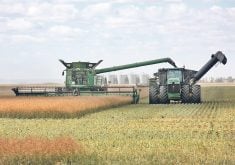YORKTON, Sask. — Evan Shout encourages young farmers to think big while making small improvements.
The president of Maverick Ag, chief financial officer at Hebert Grain Ventures and coach at Farmer Coach is a proponent of the five-percent rule, in which farmers increase yields and decrease expenses by that percentage.
American agricultural economist Danny Klinefelter has long promoted the rule. He found that the top 25 percent of farmers are only five percent better than the rest. And taking steps to make improvements of five percent, or cut costs by five percent, add up to big money.
Read Also

Feds propose overhaul of chronic wasting disease control program
Chronic Wasting disease control program getting updated by Canadian Food Inspection Agency with feedback encouraged from producers.
Speaking to a full room at the Farm Credit Canada Young Farmer Summit, Shout used an example of hard red spring wheat at a price of $8 per bushel to illustrate how it works.
The 10-year average net earning on the crop is $50 per acre. Reducing costs by five percent would push that to $72. Adding three bu. per acre to yield, or a price increase of 40 cents per bu. would result in $74 per acre.
But Shout said an increase in yield and price would earn $99 an acre, while an increase in yield and price, and not buying a new combine, would earn $121.
“What’s that mean? On a 5,000-acre farm… over 10 years, in five years you’d make $2 million more by being five percent better. In 10 years? You’d make $5 million more,” he said.
Shout said most farmers’ thoughts immediately turn to cost cutting when asked how they could be five percent better. He said that doesn’t mean reducing inputs such as fertilizer.
“When I say costs, I mean that pretty piece of machinery sitting in your backyard,” he said. “The reason is, for every dollar in inputs you put down you get about $2.45 of output.”
He noted that over the 10 years from 2006-17, farm costs went up 277 percent. If prices from the last two years are not included, the price of wheat has remained the same during that time.
While farmers like to complain about costs, the return on equity is what matters, he said.
He encouraged farmers to use their working capital properly.
“You will make more money by having working capital and selling at the right time and buying at the right time than you ever will on expenses,” he said.
He showed an example of a 40-bu. canola crop sold at the high and the low, and with inputs purchased at the high and the low.
The difference in gross margin was 81 percent, or $850 per acre when the transactions were at the best time compared to $470 per acre at the worst.
If the farmer in this example also cut costs by five percent, to $220 from $250 per acre, and added that into the equation, the difference is $630 per acre to $220 per acre.
Over a 5,000-acre farm that can be a change in earnings of $2 million.
Since Farmer Coach launched last July, Shout said the first two cohorts sold out and the third, beginning this month, is as well.
“Honestly, we had some of the most progressive farms I didn’t even know we had (attend),” he said in an interview.
Between 30 and 40 percent of the participants were from Saskatchewan, with the rest from Alberta and Manitoba as well as a few from the United States and one from France.
“The industry sees the need, obviously, and I think the farmers are at the point where they want something different,” he said.
Part of the attraction is curiosity and part of it is the strategy they learn, Shout said.
“Most farmers have never sat down, set goals, done a strategic plan,” he said. “They probably haven’t even thought what 10 years might look like and it’s intriguing to write it down on paper.”
He said the Farmer Coach program is transparent to illustrate both successes and failures and allow participants to adapt it to their operation.
His main message to the young farmers was to think big.
“We, as farmers, tend to handcuff ourselves,” he said. “Open up your mind that anything is possible. You just need to take the first step.”
Shout also encouraged farmers to build relationships with staff, hire smart people and allow them to do their jobs.
















